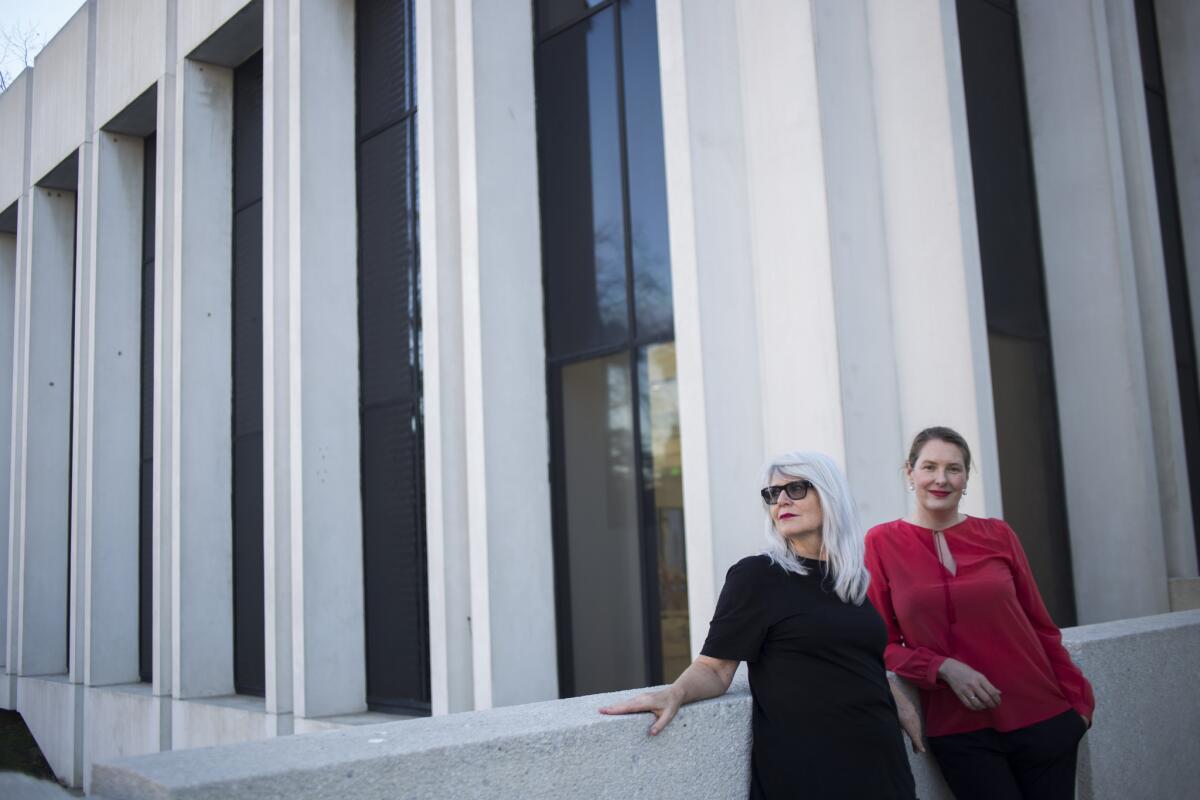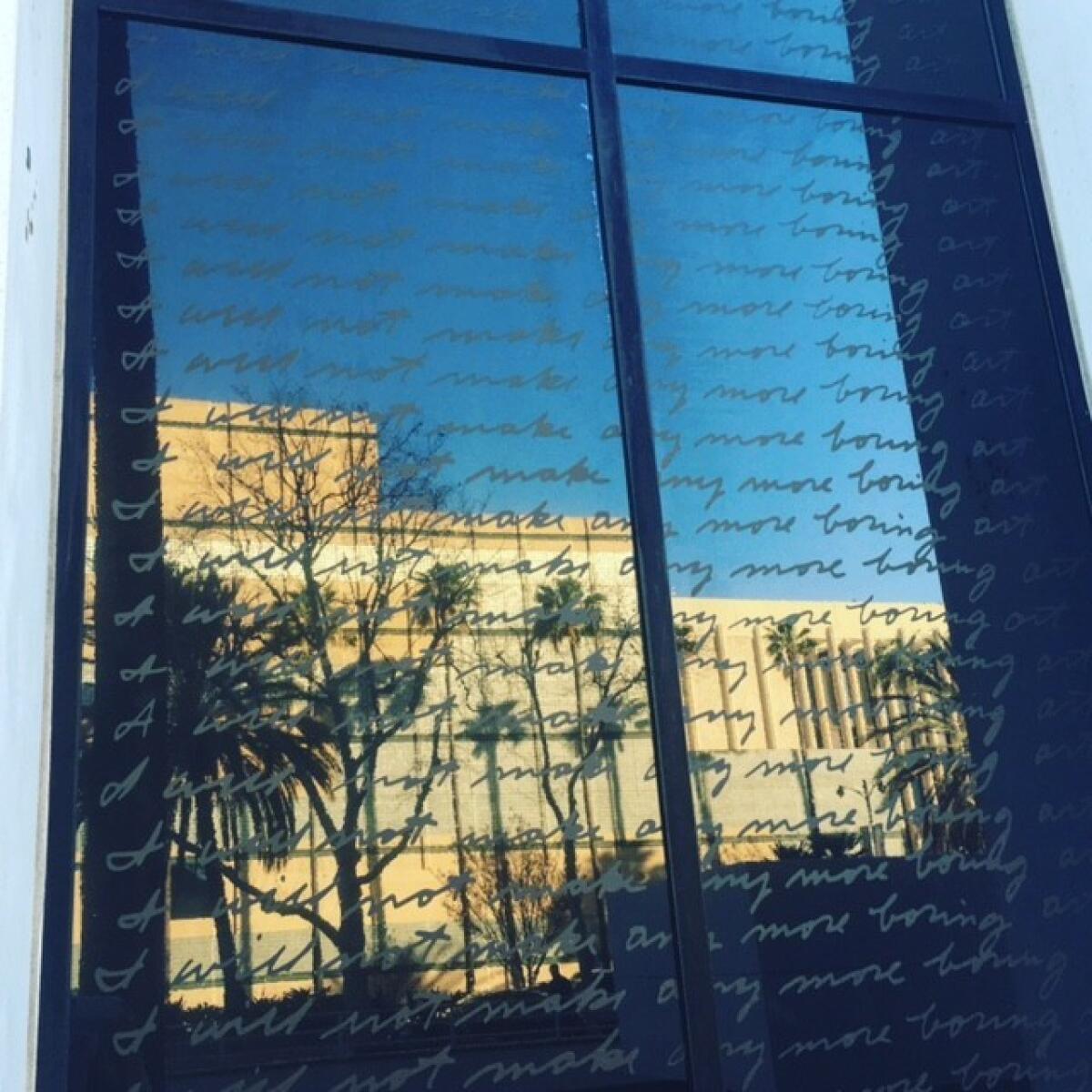German art-world feminists stake their claim in L.A. with new Sprüth Magers gallery

Monika Sprüth, left, and Philomene Magers outside Sprüth Magers in Los Angeles.
Scrawled repeatedly on the window panes of a mid-Wilshire building, from the base to the rooftop, is artist John Baldessari’s call from his 1971 lithograph: “I will not make any more boring art.”
The sentiment is also a promise of sorts from the building’s new inhabitants, gallerists Monika Sprüth and Philomene Magers. The duo -- art world feminists who paved the way in Germany in the early-to-mid-’80s for contemporary female artists such as Barbara Kruger, Cindy Sherman, Jenny Holzer, Louise Lawler and Rosemarie Trockel -- are proprietors of the Sprüth Magers gallery, which has offices in Cologne and outposts in Berlin and London.
See more of Entertainment’s top stories on Facebook >>
On Tuesday night they’re opening a U.S. arm in Los Angeles, a 14,000-square-foot, midcentury space designed by West Coast architects Pereira & Associates, directly across the street from the Los Angeles County Museum of Art. The gallery debuts with a solo exhibition of new work by Baldessari.
“We opened this for all of our artists,” Sprüth says over tea and cookies with Magers at their new offices. “But John is special. He’s the oldest, the one who’s been so influential on so many of us. It felt natural to debut with John.”
Sprüth and Magers considered New York for their U.S. debut, but L.A. seemed more appropriate, they said. The gallery represents notable West Coast artists, among them Kruger, Stephen Prina, Analia Saban, Kenneth Anger and Sterling Ruby in L.A. as well as local artists Ryan Trecartin, Lizzie Fitch and Ed Ruscha in Germany. Baldessari, 84, who’s been associated with the gallery for nearly 30 years, was key to the decision. Baldessari shows at Marian Goodman Gallery in New York but hasn’t had a local gallery exhibition since Margo Leavin Gallery closed to the public in 2012. Baldessari wanted an L.A. outpost to show new work; Sprüth and Magers responded.

The exterior of the new Sprüth Magers gallery opening on Tuesday has John Baldessari’s “I will not make any more boring art.”
“We looked at our list and realized, even beyond John, there was a vacuum,” Magers says. “We thought: ‘Oh, wait a minute, the lion’s share of our artists don’t have L.A. gallery representation!’”
The collaborative nature of the L.A. art scene also was a factor. The city has a flourishing museum scene, and Sprüth Magers has a growing collector base here. L.A. felt similar to Berlin, the gallerists say.
“In Berlin it’s hard; you have to work 50 times as much as in London,” Magers says. “But it’s a great city in terms of the artists, the discourse, the community. And you have all the great art schools and teachers. Somehow, L.A. felt like that, like Berlin.”
Baldessari was involved in the search for an L.A. building and says the new space is an unparalleled arena to show art.
“I can’t think of any show I’ve ever had where I’ve had a more beautiful space to show my work,” says Baldessari, adding that the gallery’s move to L.A. may add some competition to the gallery scene.
“They bring a European sensibility to L.A. and some competition” to the new Hauser, Wirth & Schimmel in downtown L.A., Baldessari says. He speculated that Sprüth Magers may prompt other European galleries to open here, “so it will more and more put L.A. on the map.”
Sprüth and Magers have been on the European art map for quite some time. Monika Sprüth, an avant-garde gallery in Cologne, opened in 1983 with a show by Andreas Schulze. Around that time, Sprüth published an art zine, Eau de Cologne, featuring interviews with female artists. Philomene Magers, showing new and overlooked contemporary artists who’d had their heyday largely in the ‘80s, opened in Cologne in 1991.
The two had known each other since Magers was a teenager and Sprüth was in her 30s. (Magers’ mom owned a gallery in Bonn, outside of Cologne, and introduced them.) With their shared commitment to feminism and joint vision of their role as “artists’ gallerists,” as they call it -- meaning mentors and rigorous curators who are heavily involved in conception and production of their artists’ work -- their partnership was organic. Within a year and a half of Magers’ gallery opening, they were collaborating on projects together. They merged galleries in 1998.
Both women still consider themselves feminists and artists’ gallerists.
“When you look at the real power, the financial power in the art world, there’s still a difference between the male and female artists,” Sprüth says. “It’s not resolved as a problem yet, so we’re still very aware of this.”
The answer, Sprüth says, isn’t a numbers game of simply representing more female artists. “The important thing is representing artists you think are saying something important,” Sprüth stresses, “And that we support them to the level that they are really visible. Because then they become a role model for a younger generation.”
The L.A. gallery will be managed by Anna Helwing and Sarah Watson, as Sprüth lives in Cologne and Magers in Berlin. London-based Andreas Lechthaler and Berlin-based Botho von Senger und Etterlin renovated the space. It’s two stories high, so that the gallery can feature multiple shows at once or blow out one artist, as with the Baldessari debut. The lower level exhibition space has floor-to-ceiling windows on three sides, with movable interior walls so the space can be configured to feel more intimate.
All the furniture in the offices is from female designers working in midcentury California.
“We didn’t want to have a huge gallery, but we wanted to have an interesting architectural space,” Sprüth says. “This building represents an L.A. aesthetic, it has an identity.”
Adds Magers: “It looks like a building from an Ed Ruscha photograph. And we thought: ‘Wouldn’t it be nice to furnish it with all women!’”
The Baldessari show, courtesy of Marian Goodman Gallery, will feature 16 new works on canvas, all with found imagery the artist rendered digitally, combined with painted elements and his trademark stenciled captions. The snippets of text came from movie scripts, the artist says. The imagery came from movie stills that Baldessari, a self-described “inveterate movie watcher every single night,” collects.
For its second exhibition, in April, Sprüth Magers will show new work by painter George Condo. Its third show, in June, will feature new work by female artists, including Kruger, Sherman, Holzer and Trockel.
“It’s so that people understand the history of the gallery, where we come from,” Sprüth says.
Which is a place that was pivotal for some artists, such as Kruger.
“Historically, they gave us a platform in Germany that didn’t exist,” Kruger says. “It’s very different here, now, than Germany in the early ‘80s; and they’re not about showing exclusively women artists. But their support of all artists, especially women, is organic. It’s been in place for decades and decades. I’m just really happy they’re opening here. It’s wonderful for us and for L.A.”
Follow me on Twitter: @debvankin
Instagram: @deborahvankin
More to Read
The biggest entertainment stories
Get our big stories about Hollywood, film, television, music, arts, culture and more right in your inbox as soon as they publish.
You may occasionally receive promotional content from the Los Angeles Times.











